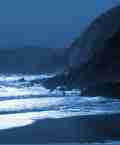

Cloughoughter Castle, County Cavan
Tucked away in a remote corner of the Erne River system, on a tiny island in Lough Oughter, stands the ruined circular tower of Cloughoughter - a modest-sized castle with a surprisingly prominent history. It was probably begun by William Gorm de Lacy between 1200 and 1224, possibly on the site of a crannog, after the Normans seized parts of the O'Rourke kingdom of Breifne. The lower two storeys can be ascribed to this phase; it had loops but no entrance on the ground floor, three doorways and at least two windows at first-floor level and possibly a curtain wall on the west side.
From 1233 until the end of the seventeenth century, the territory of East Breifne, roughly today's County Cavan, fell under the control of the O'Reilly clan, who built up the castle to its present height. It played an important role in the dynastic power struggles of the O'Reillys and in conflicts with their former overlords, the O'Rourkes of West Breifne, and during this time also served as a grim prison, where some unfortunates were incarcerated for years. When Philip O'Reilly was held here in the 1360s he had "no allowance save a sheaf of oats for day and night and a cup of water, so that he was compelled to drink his own urine".
After the Flight of the Earls in 1607, the castle was captured by Sir Richard Wingfield and granted to Captain Hugh Culme, who built himself a residence on the south shore of the lake. In the 1641 Rebellion the castle was captured by the O'Reillys and used again as a prison; here the old Bishop of Kilmore, William Bedell, together with his two sons, his son-in-law and Arthur Culme, were kept in irons in a "cold, wet and windy room almost at the top of the tower". It was the last stronghold to fall in the Cromwellian wars and immediately afterwards, in March 1653, was rendered useless by a massive explosion of gunpowder. During the eighteenth and nineteenth centuries the picturesque ivy-clad ruin was depicted by a number of artists, including William Ashford, whose fine painting of the castle c. 1790 hung at Fota until recently. Excavation was carried out to facilitate conservation works on the walls in 1987, most of the finds were of seventeenth century date, including four human skeletons, three male and one female, all evidently casualties of the final fatal siege of 1653.
Located on an island in Lough Oughter
3 miles SE of Killeshandra and S of Killykeen Forest Park.
NGR: H 863554.
National Monument.
Open access.
Click here Irish Castles to buy the book from Amazon.com or here to buy the Appletree Press book from Amazon.co.uk. For more information of the Appletree Press title, click on: "Irish Castles".
[ Back to Top | to Irish Castles | to Attractions ]
All Material © 1999-2006 irelandseye.com and contributors Privacy statement
